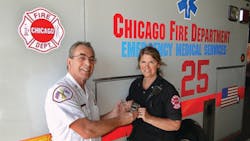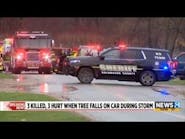It was a warm summer day on the Saturday before Father’s Day in June 2012. Veteran Chicago, IL, Fire Department (CFD) Paramedic Anne Gradolf responded to a call for an ambulance on the city’s southeast side. The boyfriend of a young woman who was sick with severe flu-like symptoms placed the call. At the scene, Gradolf noticed both the woman and her boyfriend appeared lethargic. The woman refused to go to the hospital, insisting she just had the flu and needed to stay home and rest. After checking her vital signs and not finding anything amiss, Gradolf had the woman sign a medical release and headed back to her vehicle.
“I had done what I was supposed to do, but there was just something about the way they were acting,” said Gradolf. “Their sluggish appearance haunted me. It was just a gut instinct that something else was going on here; it just didn’t feel right.”
Before reaching her vehicle, Gradolf made an about-face and went back to the residence. On her return, others in the home were awakened and she noticed everyone had a similar “dazed and lethargic look.” She also discovered there were 10 people in the home, ranging in age from 70 years old to a baby about one year old.
She called for a fire company, which used a portable gas-detection instrument to quickly determine the presence of carbon monoxide (CO), an odorless and highly toxic gas. It turned out the occupants in this home were sick from CO poisoning. With readings at 400 parts per million (ppm), it would not have taken long for this incident to turn lethal.
“It was summertime, so you are not necessarily thinking CO,” Gradolf said. A malfunctioning water heater was discovered to be the source of the toxic gas. Everyone went to the hospital, including three of the residents with exposure severe enough to require treatment in a hyperbaric chamber.
“This could have been a major tragedy,” CFD Deputy District Chief Robert Anthony said. He cites the incident to explain why he instituted a new standard that requires on-duty paramedics to wear CO gas-detection meters. The new standard and related protocols were implemented May 1 and impact all 75 of the city’s frontline ambulances that cover Chicago streets 24/7.
Invisible threat
For the City of Chicago, with its bone-chilling winters that keep residents sealed indoors with gas heaters and fireplaces blasting, this incident is just one of many each year involving CO poisoning. While CO incidents primarily occur during the seasonally cold months, they can occur year-round, as Gradolf discovered first-hand.
CO is a colorless, odorless gas formed when fossil fuels fail to completely burn, often from water heaters, gas appliances, furnaces or fireplaces. It can render victims unconscious or in a coma before causing long-term health damage or becoming lethal. In the U.S., firefighters and EMS professionals deploy gas-detection monitors to keep their personnel and the public safe from exposures.
In one national study, conducted over a five-year period by the U.S. Centers for Disease Control and Prevention (CDC), 16,447 unintentional deaths related to CO poisoning occurred countrywide from 1999 to 2004, accounting for an average of about 3,280 deaths a year during the study period.
“Our responders enter situations all the time where somebody’s not feeling good or there’s a person down and unconscious,” Anthony said. “Unless it’s verified with a gas-monitoring device, the potential is always there for our people to get hurt from carbon monoxide exposure. It’s a dangerous, invisible threat.”
Protecting paramedics
Anthony said he instantly realized the potential for protecting paramedics in the field when he first saw the compact size of RAE Systems’ ToxiRAE 3 single-gas monitor. The device is about the same size as the shoulder radio worn by first responders. After investigating the monitor and evaluating competitors, he requested funds to purchase the units for the large fleet of ambulances under his direction.
“Its small size was perfect for ambulance use,” Anthony said. “We ran with single-gas meters on our engines many years ago, but it was a clunky, big device. This compact gas monitor was perfect.”
While many EMS professionals often carry meters in their vehicles or bags, the devices seldom get used because technicians “get caught up in the problems of the moment,” Anthony said, and forget to turn the unit on. In contrast, the CFD’s latest addition to its standard operating procedures (SOPs) requires paramedics to keep the gas monitor for CO on and attached to their radio straps throughout their shift – positioned on their chests – to provide protection from CO in their breathing zone. Paramedics follow start-up protocols for the monitors at the beginning of their day, but don’t even realize it’s there the rest of the time, said Anthony.
Before issuing the monitors, the CFD conducted a 30-day trial with five ambulances to ascertain the best protocols based on actual usage. Training also was conducted to familiarize the EMS teams with the simple two-button operation, bump testing and calibration protocols, in addition to how to interpret readings.
The immediately dangerous to life or health (IDLH) threshold for the CFD is 100 ppm for CO, a level that requires responders to don self-contained breathing apparatus (SCBA) and remove people from the location. At lower readings where there are elevated levels of CO, responders typically can address the issue by improving ventilation. In both instances, the gas company is called to the scene to address gas leaks.
For Gradolf, who has been with CFD for 21 years, the new single-gas meters for detecting CO are a welcome safety tool.
“I had to rely on instinct before,” she said. “Now, we have meters that give us real-time alerts so we can catch things that we wouldn’t have always caught, even with our training and medical skills. Having a monitor is like having a third eye.”
Lives saved in Idaho
Chicago is not alone in its effort to reduce the threat of CO poisoning by equipping EMS teams with single-gas meters to detect the deadly gas. Lieutenant/Paramedic Seth Martin of the Ketchum, ID, Fire Department, said lives have been saved using the ToxiRAE 3 single-gas meter for CO. One month after deploying the meters in 2009, he and his team entered a residence where they found two victims – one unconscious and the other sick and confused.
“Almost instantly, our ToxiRAE 3 meter started alarming,” he said. “This confirmed we had an environment that was immediately dangerous to life and health, and we rapidly removed the two victims and ourselves from the home. The instrument ended up saving their lives, and kept us safe. They were both evacuated by air ambulance to a hyperbaric chamber.”
PRAVEEN SHARMA is director of product management for RAE Systems. He joined RAE Systems in 2011 from LifeScan (Johnson & Johnson), where he was a senior program manager. Previously, Sharma held software engineering and product management positions at Oracle, PeopleSoft and Plexus. He received a bachelor’s degree in computer science at the University of Punjabi in India.
Praveen Sharma
PRAVEEN SHARMA is director of product management for RAE Systems. He joined RAE Systems in 2011 from LifeScan (Johnson & Johnson), where he was a senior program manager. Previously, Sharma held software engineering and product management positions at Oracle, PeopleSoft and Plexus. He received a bachelor’s degree in computer science at the University of Punjabi in India.






